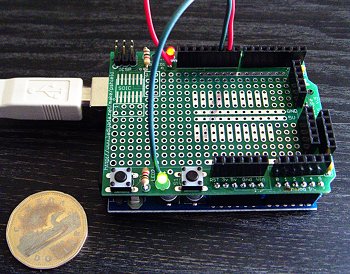
Arduino and prototyping shield
Yesterday, my Arduino board showed up in the mail. It’s pictured in the photo alongside a Canadian dollar from when I drove up to Alaska. I ordered it with a prototyping shield and Getting Started with Arduino, a book written by one of the developers of the Arduino platform. The book is a great introduction to the hardware and the software you use to control the gadget. To fully appreciate the book, you’ll want to get a few extra extra components so you can try the experiments in the book. These include a breadboard, solid core wire for the breadboard, a button, light sensor, LEDs, and a variety pack of resistors.
What is it? It’s a very simple computer connected to fourteen digital input / output pins, six analog input / output pins, and a USB communication system so you can read data and put programs on the system. In other words, you can read data from the environment, control things based on that data, and send data back to a computer all on the same small board. I’m interested in using the platform to build my own weather station to complement the professional station we have. But more generically what’s cool about it is that it provides an inexpensive (my board was $35) platform for “programming” the world. Instead of buying a gadget off the shelf that someone else has built to perform a task they think you’ll want, you can build something to do exactly what you want.
In the real world.
All I’ve done with it so far is to control the flashing of the pair of LEDs that came with the prototyping shield. I know that doesn’t sound very exciting, but if you can control LEDs and make them go on and off, or vary their intensity, that means you can control anything that takes an on / off, or variable input. For example, a set of fans in your house whose speed and direction is controlled by the relationship between the temperature in the house, in the attic, and outside. Or controlling a sprinkler system that senses how wet the ground is, reads the weather forecast from the Weather Service and only turns on the sprinklers if no rain is expected. Or a system that operates a dog door, sensing which dog has approached by reading an RFID tag on their collar and then opening or locking the door depending on whether they are allowed in or out.
You get the idea. Combining any of the wide variety of input sensors available with the ability to do things based on logic that you control is a really powerful tool. And the low cost of the board makes it reasonable to experiment and try things out until you get a system working the way you want.
My initial project will include a series of temperature sensors that I’ll put in different places in the house and outside (maybe even in a dog house?), a light sensor and a barometric pressure sensor. Of course, you can buy small weather stations that have all of these things in them, but most can’t read temperatures below -40°F, and most only have one sensor. Best of all, I’ll plug mine into a “real” computer via USB and record the data as it comes in.